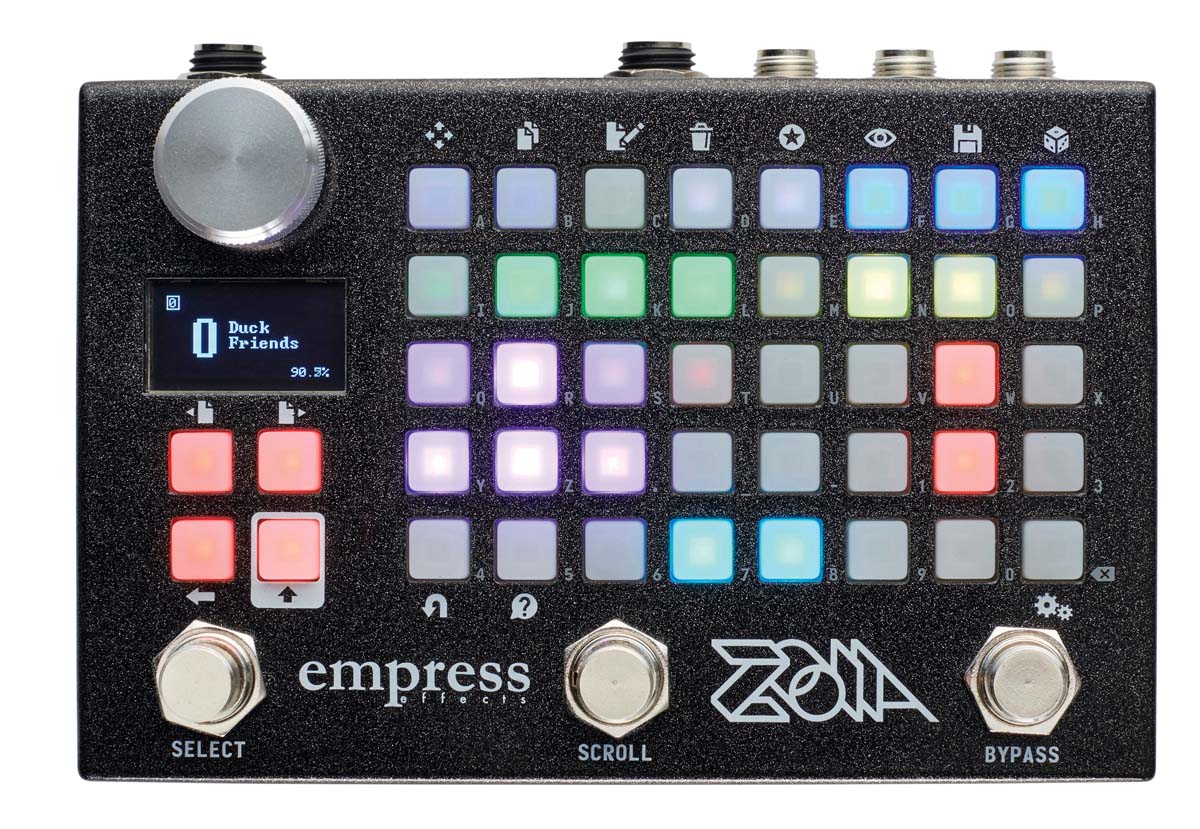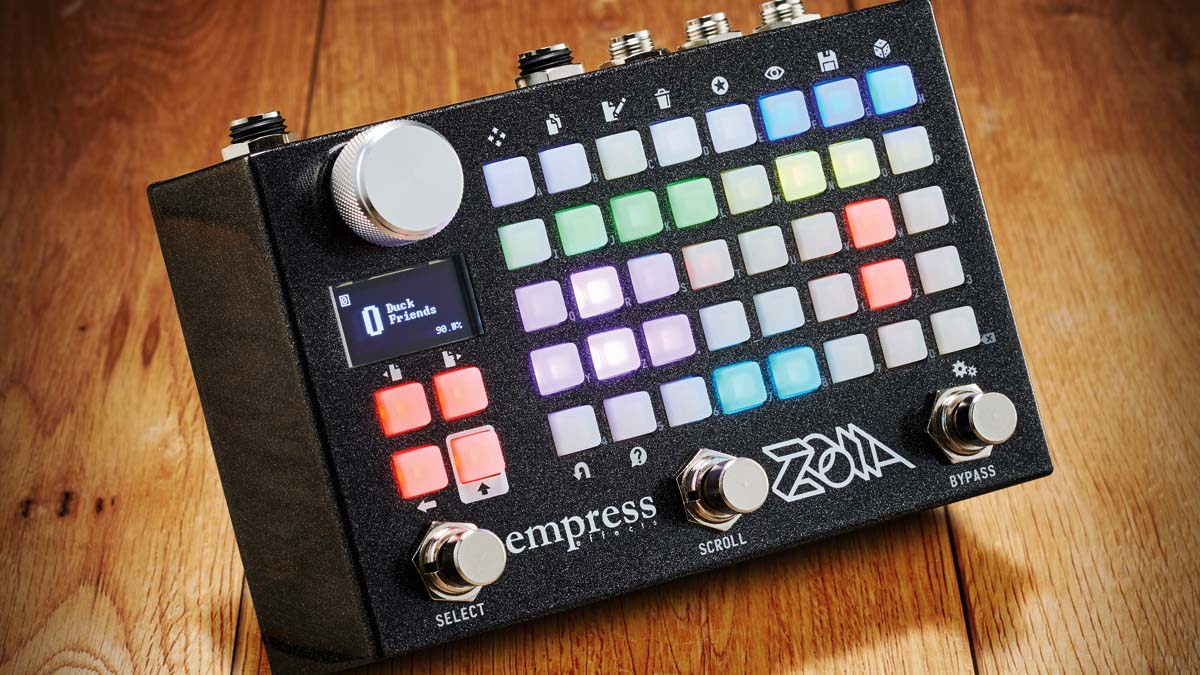Guitar World Verdict
Getting the best out of Empress’s Zoia will require a little knowledge of how effects work and what various synthesizer terms mean, but with just a modicum of learning and imagination the Zoia can take your musical vision to another creative level.
Pros
- +
Build your own custom effects.
- +
Logical and intuitive operation.
- +
Outstanding sound quality.
- +
Also functions as an instrument/synth.
Cons
- -
Requires learning.
- -
No stereo headphone socket.
You can trust Guitar World
The Guitarist team are suckers for good old-fashioned vintage gear, but we are also huge fans of technology. Be it the simplest analogue application or cutting-edge digital modelling, if it sounds right and feels right, the chances are it is.
And with Empress Effects’ “infinite trick pony” – the Zoia – creating such a buzz in the stompbox world recently, we couldn’t wait to dive in and find out why people have been raving about this quirky little box with what seems like far too many buttons.
Although it may appear unfamiliar or slightly confusing at first, that grid of 40 buttons is precisely what makes working with the Zoia such a breeze.
Think of them as spaces. Press an unoccupied one to choose a module from the screen menu using the rotary knob (not forgetting to pick a suitable colour, of course!) and a number of buttons light up in a row depending on how many parameters and inputs/outputs the module has.
To link different modules together simply press two buttons simultaneously, like the output of reverb to the input of tremolo, and to tweak their parameters just hit a relevant button and use the rotary knob to adjust. Easy!
If you have zero experience hooking up synth modules, fear not. Empress has included a bunch of ready-made guitarist-friendly effects
“But what is this ‘module’ nonsense?” we hear you cry. The Zoia is a modular synthesizer in pedal form, but that doesn’t mean it’s off the radar as far as us guitarists are concerned. Indeed, quite the opposite: the very same principles have long been used to design guitar pedals.
What makes the Zoia unique, however, is that with a little imagination you can easily customise your own effects. And without needing a studio full of synth modules, or a soldering iron for that matter, in order to do so.
Furthermore, with 64 patches available to save your work and instantly recall it on the fly using the Scroll and Select footswitches, or via MIDI, you can create a virtual pedalboard full of possibilities.

If you have zero experience hooking up synth modules and would like to start using the Zoia straight out of the box then fear not. Empress has included a bunch of ready-made guitarist-friendly effects modules to choose from.
The Canadian company has been hard at work updating the firmware with new and exciting modules since the Zoia’s release, often based on recommendations from an ever-growing online community of users.
At the time of writing, it boasts 20 effects modules including an EQ, overdrive/distortion, fuzz, compressor, noise gate, phaser, flanger, chorus, vibrato, tremolo, envelope filter, ring modulator and cab simulator, along with two delays and five reverbs partly derived from Empress’s popular Reverb pedal.
Sounds
Although the above effects merely scratch the surface of the Zoia’s capabilities, they alone would be enough to elicit a rave review.
Take the OD & Distortion module, for example: it may not replace your favourite dirt pedal(s) – and it’s worth bearing in mind here that you can easily set up an effects loop to patch external devices in – but the overdrive is clear, open and surprisingly natural-sounding enough to give the best of them a run for their money.
Sporting a range of options including Plexi, Germ, Classic, Pushed and Edgy, along with adjustable input and output gain, the OD & Distortion module covers an impressive range of sonic ground.
Further tone-shaping is available courtesy of the Tone Control EQ module, while the Cabinet Sim module rounds things off nicely with 4x12 Full, 2x12 Dark, 2x12 Modern, 1x12, 1x8 LoFi, 1x12 Vint and 4x12 HiFi options.
The Zoia excels at large, complex sounds and unique custom-detailed effects of an experimental nature
Although the Zoia can do tons of classic guitar tones, it excels at large, complex sounds and unique custom-detailed effects of an experimental nature, where creating the same kind of thing would be difficult, if not impossible, using regular pedals.
For example, you might envisage a tremolo that speeds up and slows down depending on your picking strength. No problem: just pop down the Envelope Follower module to analyse your incoming guitar signal then attach it to the LFO controlling the volume of a VCA audio module – and job done!
Verdict
Getting the best out of Empress’s Zoia will require a little knowledge of how effects work and what various synthesizer terms mean, such as envelope, LFO, VCA and so on, but with just a modicum of learning and imagination the Zoia can open up possibilities that take your musical vision to another creative level.
Specs

- PRICE: $499 / £479 / €533
- ORIGIN: Canada
- TYPE: Multi-effects/synthesizer
- FEATURES: 20 ready-made effects; 23 audio modules; 22 control modules; 16 interface modules; 3 analysis modules; 64 writable patches; MIDI in/out; CV in/out; exp. pedal; ext. switch; 3x assignable footswitches
- CONTROLS: 1x rotary knob; buttons: 4x utility buttons (Page Left/Right, Back and Shift); 40x module grid/ page buttons (alternative/Shift functions include Move, Copy, Edit, Delete, Star, View, Save, Random, Undo, Help and Configure Menu); Select, Scroll & Bypass footswitches
- CONNECTIONS: Left/right input & left/right output standard jacks; Control Port jack for ext. switch/exp. pedal/MIDI in & out/0-5V control voltage in & out; 2x MIDI mini jacks: in & out (2x 3.5mm/5-pin dongles supplied); micro SD card slot (card and adaptor supplied)
- POWER: 2.1mm centre negative 9V DC adaptor (not supplied); 300mA current draw
- DIMENSIONS: 145 (w) x 95 (d) x 67mm (h)
- CONTACT: Empress Effects
Rod Brakes is a music journalist with an expertise in guitars. Having spent many years at the coalface as a guitar dealer and tech, Rod's more recent work as a writer covering artists, industry pros and gear includes contributions for leading publications and websites such as Guitarist, Total Guitar, Guitar World, Guitar Player and MusicRadar in addition to specialist music books, blogs and social media. He is also a lifelong musician.
“The original Jordan Boss Tone was probably used by four out of five garage bands in the late ’60s”: Unpacking the gnarly magic of the Jordan Boss Tone – an actual guitar plug-in that delivers Dan Auerbach-approved fuzz
“This is a powerhouse of a stompbox that manages to keep things simple while offering endless inspiration”: Strymon EC-1 Single Head dTape Echo pedal review












